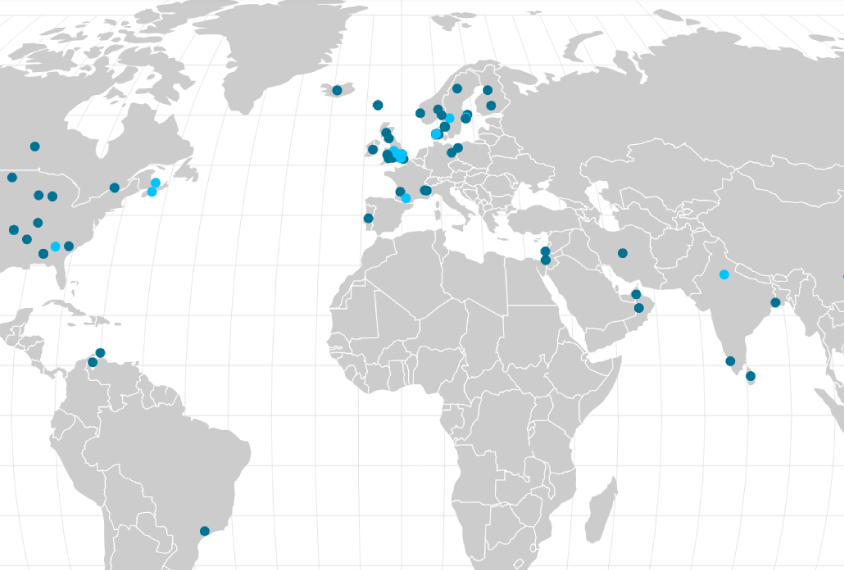
About the map:
This map was created by the team at Spectrum, the leading source of news and expert opinion on autism research. (Subscribe to our newsletters.)
The map features a collection of studies on autism prevalence around the world. It highlights places where information is available — and places where information is missing.
Each dot on the map represents a study. To identify these studies, we relied on our expert advisers. The darker dots represent studies that are recommended by the advisors for one or more reasons — although these studies may still be flawed in other aspects.
We plan to update the map with new studies as they become available.
How to use the map:
To see more information about a particular study, click on the corresponding dot. The window that pops up has key pieces of available information from that study.
You can also view and filter the studies in the ‘list’ view. In either the map or the list view, you can use the filters in the top-right corner to display studies that match certain criteria, such as sample size, prevalence estimate and study type. And you can use the timeline at the bottom of the page to filter by the years in which studies were conducted or published.
Key to terms used on the map:
Prevalence is shown on the map as the estimated number of autistic people per 10,000 individuals in the population studied.
Confidence interval refers to the uncertainty of a prevalence estimate. It is the range in which the true prevalence lies 95 percent of the time.
When available, the study shows the proportion of participants with at least an average intelligence quotient (IQ) — the definition of ‘average’ IQ varies from study to study but typically refers to a score above 70 or 80.
Diagnostic criteria include the following options:
ABC — Autism Behavior Checklist
ADOS — Autism Diagnostic Observation Schedule
ADI, ADI-R — Autism Diagnostic Interview, Autism Diagnostic Interview-Revised
Autistic Disorder
CABS — Clancy Autism Behavior Scale
CARS — Childhood Autism Rating Scale
CCMD-2, CCMD-2-R — Chinese Classification of Mental Disorders, 2nd edition
Clinician diagnosis
DAWBA — Development and Well-Being Assessment
DISCO — Diagnostic Interview for Social and Communication Disorderss
DSM-III, DSM-III-R, DSM-IV, DSM-IV-TR, DSM-5 — editions of the Diagnostic and Statistical Manual of Mental Disorders
Gillberg criteria — Christopher Gillberg’s diagnostic description
ICD-8, ICD-9, ICD-9-CM, ICD-10 — editions of the International Classification of Diseases
INDT-ASD — INCLEN Diagnostic Tool for Autism Spectrum Disorder
Kanner criteria — Leo Kanner’s diagnostic description
SCDC — Social and Communication Disorders Checklist
SCQ — Social Communication Questionnaire
SRS — Social Responsiveness Scale
Rating scale
RDC — Research Diagnostic Criteria
Rutter criteria — Michael Rutter’s diagnostic description
Study type includes the following options:
Epidemiological survey — active case-finding with two-stage screen and case confirmation
Registry — analysis of already-identified cases in research databases
Administrative database — classifications based on existing documented provision of services
General health survey — reported symptoms or diagnoses in a population-based survey sample
Research cohort — individuals identified for research projects and followed over time
Category includes the following options:
AD — autistic disorder
PDD — pervasive developmental disorder
ASD — autism spectrum disorder
More information:
Here is a selection of Spectrum articles on autism prevalence.
Study quantifies prevalence of autism in India
New report shows slight uptick in autism prevalence
Prevalence of autism in U.S. remains steady, new data suggest
School survey in India reveals low autism prevalence
U.S. stats show autism rate reaching possible plateau
New spike in autism numbers may reflect rise in awareness
Prevalence perturbed
Clinical research: Israeli study shows high autism prevalence
Rising rates
Study finds high rate of autism in South Korea
The team:
Spectrum Team
Apoorva Mandavilli
Editor-in-Chief, Spectrum
Apoorva Mandavilli created Spectrum and conceived of the global prevalence map. She oversees the site’s operations.
More
Nicholette Zeliadt
Senior News Writer, Spectrum
Nicholette Zeliadt reports and writes news and features about autism research. She led the map’s build on the editorial side.
More
Rebecca Horne
Multimedia Director, Spectrum
Rebecca Horne oversees and directs all multimedia on Spectrum. She commissioned and oversees the map’s design.
More
Michael Kranz
Lead Web Developer, Simons Foundation
Michael Kranz manages interactions between Spectrum and the team designing and developing the map site, as well as overseeing the map site’s infrastructure.
Ursula Wing
Web Developer, Simons Foundation
Ursula Wing contributes to the development of the map.
Hope Vanderberg
Copy Chief
Hope Vanderberg edits articles on Spectrum for grammar and accuracy.
More
Project Advisers
Gauri Divan
Director of the child development group, Sangath
Gauri Divan is director of the child development group at Sangath, a nonprofit organization in Goa, India.
More
Maureen Durkin
Professor of population health sciences, University of Wisconsin-Madison
Maureen Durkin is professor and chair of population health sciences and Waisman Center investigator at the University of Wisconsin-Madison.
More
Mayada Elsabbagh
Assistant professor of neurology and neurosurgery, McGill University
Mayada Elsabbagh is assistant professor of neurology and neurosurgery at McGill University in Montreal, Canada.
More
Eric Fombonne
Director of autism research, Oregon Health and Science University
Eric Fombonne is director of autism research at the Institute on Development and Disability at Oregon Health and Science University.
More
Catherine Rice
Director, Emory Autism Center
Catherine Rice is director of the Emory Autism Center and professor of psychiatry and behavioral sciences at Emory University in Atlanta, Georgia.
More
Recommended reading

Autism traits, mental health conditions interact in sex-dependent ways in early development

New tool may help untangle downstream effects of autism-linked genes

NIH neurodevelopmental assessment system now available as iPad app
Explore more from The Transmitter
It’s time to examine neural coding from the message’s point of view

Organoids and assembloids offer a new window into human brain
